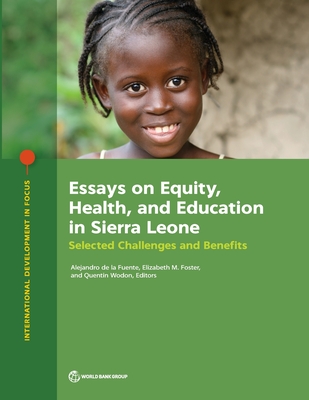Essays on Equity, Health, and Education in Sierra Leone: Selected Challenges and Benefits

Essays on Equity, Health, and Education in Sierra Leone: Selected Challenges and Benefits
Sierra Leone is one of the poorest countries within Sub-Saharan Africa, with a gross national income (GNI) per capita of US$510 in 2022. The country ranked near the bottom of all countries in the latest Human Development Index. Despite these low rankings, in the 15 years since the end of the civil war in 2002, there has been notable progress. The return to peace and stability and the ample availability of fertile land facilitated recovery and growth in agriculture. Urban areas have become local trading and commercial centers, and the capital of Freetown has seen many sources of new wealth and development. Poverty significantly declined from 2003 to 2011. Progress continued, although less emphatically until 2018, and access to basic services improved, particularly in education and health. Sierra Leone has made strides in key indicators on education and health, including the expected years of schooling and the primary completion rates. Strong gains in reducing under-five and maternal mortality, as well as under-five stunting, since the end of the war have also been observed. However, improvements in some of these dimensions should not distract policy makers from the challenges posed by the relative lack of progress in others. Adolescent girls in Sierra Leone continue to have relatively high rates of child marriage and early childbearing, and low educational attainment. Moreover, improvements have not permeated to the entire population. The rural poor in particular have suffered from a relative lack of progress. This book examines the evolution of poverty and human development outcomes since the end of the 10-year civil war in 2001 and asks if the foundations for creating shared prosperity and addressing persistent poverty in Sierra Leone have been laid down through key policies in these sectors.
Sierra Leone is one of the poorest countries in Sub-Saharan Africa, with a gross national income per capita of US$510 in 2022. The country ranked near the bottom of all countries in the latest Human Development Index. Despite these low rankings, in the years since the end of the 10-year civil war in 2002, Sierra Leone has made notable progress. The return to peace and stabilit
PRP: 277.43 Lei
Acesta este Prețul Recomandat de Producător. Prețul de vânzare al produsului este afișat mai jos.
249.69Lei
249.69Lei
277.43 LeiLivrare in 2-4 saptamani
Descrierea produsului
Sierra Leone is one of the poorest countries within Sub-Saharan Africa, with a gross national income (GNI) per capita of US$510 in 2022. The country ranked near the bottom of all countries in the latest Human Development Index. Despite these low rankings, in the 15 years since the end of the civil war in 2002, there has been notable progress. The return to peace and stability and the ample availability of fertile land facilitated recovery and growth in agriculture. Urban areas have become local trading and commercial centers, and the capital of Freetown has seen many sources of new wealth and development. Poverty significantly declined from 2003 to 2011. Progress continued, although less emphatically until 2018, and access to basic services improved, particularly in education and health. Sierra Leone has made strides in key indicators on education and health, including the expected years of schooling and the primary completion rates. Strong gains in reducing under-five and maternal mortality, as well as under-five stunting, since the end of the war have also been observed. However, improvements in some of these dimensions should not distract policy makers from the challenges posed by the relative lack of progress in others. Adolescent girls in Sierra Leone continue to have relatively high rates of child marriage and early childbearing, and low educational attainment. Moreover, improvements have not permeated to the entire population. The rural poor in particular have suffered from a relative lack of progress. This book examines the evolution of poverty and human development outcomes since the end of the 10-year civil war in 2001 and asks if the foundations for creating shared prosperity and addressing persistent poverty in Sierra Leone have been laid down through key policies in these sectors.
Sierra Leone is one of the poorest countries in Sub-Saharan Africa, with a gross national income per capita of US$510 in 2022. The country ranked near the bottom of all countries in the latest Human Development Index. Despite these low rankings, in the years since the end of the 10-year civil war in 2002, Sierra Leone has made notable progress. The return to peace and stabilit
Detaliile produsului










